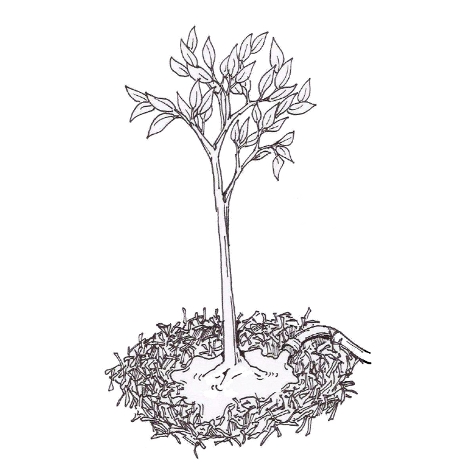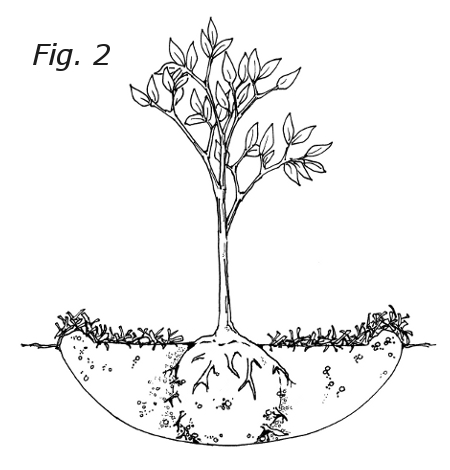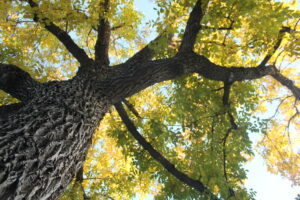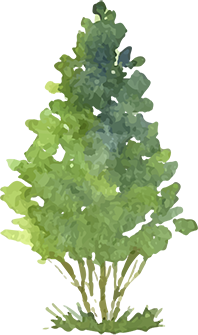Caring for Newly Planted Trees

A tree is most vulnerable during its first few years after transplant. Support your young tree’s health and survival with proper care.
Water
Proper watering is crucial to your tree’s health and survival. Both under- and over-watering can kill a tree. Because each site is different and Colorado weather varies from year to year, it is important to check your site’s soil moisture to determine your watering schedule.
Dig up soil 3-8 inches below the surface, just outside of the root area. Roll the soil between your fingers to form a small ball. If the soil does not stick together, it needs water. If it does stick together, wait on watering and check back later.
To give you an idea of what to expect, here is a rough watering schedule for the first 3 years, leaving a trickling hose at the base of the trunk for 30 minutes during each watering:
– April-May: once every 2 weeks
– June-August: once each week
– September-October: once every 2 weeks
– November-March: once a month during times when the temperature is over 50 degrees


Mulch
Mulch helps maintain soil moisture, reduces soil erosion, prevents weeds from competing for water and nutrients, and keeps mowers away from the tree trunk. Maintain a 3-inch deep, 3- to 4-foot-wide circle of mulch on top of the soil around the base of your tree. Keep the mulch several inches away from the trunk, so that the tree’s trunk flare can “breathe” (Fig. 2).
Note: Each Denver Digs Trees applicant receives a bag of mulch with his/her tree.
Wrap
Tree wrap helps protect the thin bark of young trees from sunscald in the winter. Sunscald can result when the dormant cells of young trees become activated by high intensity sunlight, as the sun is at a lower angle in the winter months. As the temperature drops after sunset or with a change in the weather, these active cells are killed, leaving a wound on the tree.
To avoid sunscald, in November wrap trees upward from the base of the tree to the lowest branches for the first three years. Be sure to remove the wrap in April to prevent girdling (strangling) and potential insect damage.
Stake
We do not generally recommend staking trees unless necessary (i.e. the tree will not stand straight on its own, which is more often an issue with bareroot trees than balled-and-burlapped and container trees). Too often, staking materials serve no necessary function and are left on too long, resulting in a girdled (strangled) trunk and a dead tree. Also, many people tie stakes to trees too tightly, so the trees do not sway in the breeze. This prevents them from developing the strength to adapt to strong winds. So, if your trees stand straight on their own, avoid staking them. Visit this link for recommended staking techniques.
Prune
At the time of planting, prune off only broken and dead branches to leave healthy foliage available to produce energy for the tree during establishment. Over the next few years, prune suckers at the base of the tree and branches that cross and rub one another. Proper pruning cuts are crucial to minimizing disease and enabling a tree to seal off its wound. Visit this link for recommended pruning techniques.
Print New Tree Care Instructions (English & Spanish)
Resources for Tree Care
- Denver’s Office of the City Forester – The City’s arboreal inspectors provide education to residents about tree care and health issues. They can answer almost any question you may have about trees via phone and email and also schedule site visits for some issues. They are also tasked with issuing permits and enforcing regulations governing the planting and removal of trees. So you may contact them directly to request a street tree planting permit if you are planting on your own, outside of Denver Digs Trees. Find your arboreal inspector.
- Licensed Tree Care Companies – In Denver, anyone performing tree care services, including pruning and removal, must be licensed as a “Tree Service Company.” The Office of the City Forester provides a current list of companies licensed to perform tree work in the City & County of Denver.
- Caring for Storm-Damaged Trees – Colorado State Forest Service’s First Aid Tips for Snow-Damaged Trees and Guide to Caring for Storm-Damaged Trees.



